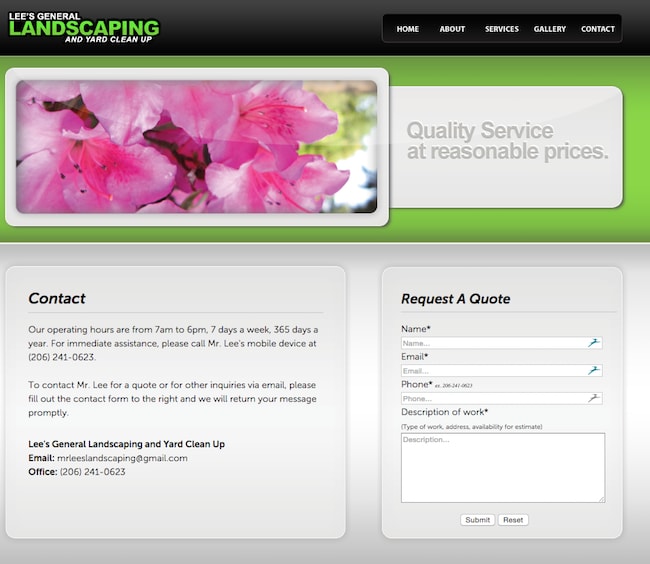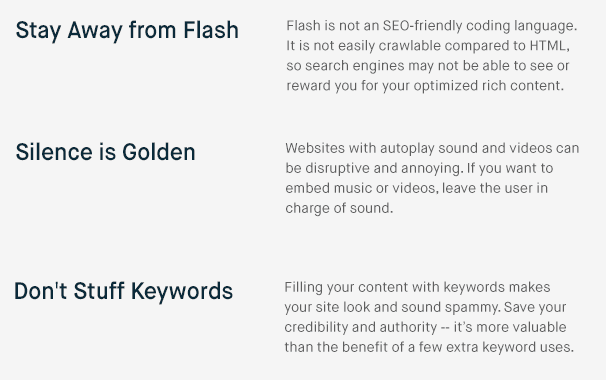Optimizing Your Website: What Every Small Business Should Know
If you want to grow your small to medium-size business, you need to rank well in online search results. As many as 90% of customers check online reviews before making a purchase,¹ and 98% of web users choose a business that is on the first page of their search result.² To most Internet users, if you aren’t there, you don’t exist.

Yet in 2012, only 42% of small businesses had a website,³ and today many businesses are unable to build trust with online customers because their websites are incomplete, with limited information and unruly designs.
That’s where we come in.
At Expertise.com, one of our goals is to help small and medium-size businesses like yours improve their digital footprint. A quality website helps your customers make better decisions for themselves and improves your business’ ranking in search engine results pages (also known as SERPs).
The following guide is designed to help time and resource-constrained businesses make simple and impactful changes to their search engine optimization (SEO) strategy. Our recommendations will cover the key ingredients needed to improve a site’s quality in the eyes of humans and web crawlers.
Business Services Near MeOptimize Local Listings
Post essential information on every page
To rank well in local search results and attract customers, your site needs to immediately and effectively answer the following questions:- Who are you?
- What service(s) do you provide?
- Where are you located?
- When are you open?
- How can you be contacted?
- Business name
- Address
- Phone number
- Hours of operation
- Map and service areas
- Business license number (if applicable)
- Social media buttons (a strong social media presence can give your business added credibility, to both customers and search engines)

Put yourself on the map
Many web users search for local stores on map platforms like Google Maps. To gain traction with these customers, you need to get included in Google’s local results.For your business to qualify, it must have:4
- A staffed, physical address (not a P.O. Box or virtual office)
- A local area code phone number (not a toll-free or vanity number)
- Face-to-face interactions with customers, either at the business (like a doctor’s office) or the customer’s location (like an electrician)
- Citation quality and consistency
- Your business category
- Proximity to searched location
- User-generated content
- Traditional SEO factors
Target the right keywords
Keywords are a critical part of SEO strategy. Keywords are the words or phrases relevant to your business that help search engines and readers know what your site is about.Keywords tell a lot about a user’s intent, so separate your pages accordingly to give each customer the information they are looking for. For example, someone searching for “Joe’s Pizza menu” has a very different intent than someone searching “Joe’s Pizza jobs,” and should be guided to a separate page.
Targeting separate keywords on separate pages lets you direct customers to a page that best answers their questions.8 Each page can have a clearer focus, which will benefit your customers and your SEO.
Your keyword strategy should target both brand and non-brand terms. For “Snapshot Photography” in Brooklyn, New York, the brand keywords would be the business name, Snapshot Photography, and geo-specific phrases such as Snapshot Photography Brooklyn NY. The non-brand terms would likely include professional photographer, Brooklyn professional photographer, wedding photographer, certified professional photographer, passport photographer, and much more. If you’re unsure of what keywords to target, read Search Engine Land’s guide to effective keyword targeting.9
Create consistent citations
Your business’ name, address, and phone number (sometimes abbreviated as NAP) should be identical across your web presences.Why? Search engines such as Google compare data from their own maps databases with citations from sites such as Yellow Pages, Yelp, and CitySearch.10 Each citation helps verify the accuracy of your business.
Inconsistencies in your business name, location, hours of operation, license information, and more can hurt your ability to rank in local search results. So whether you use street or st., Suite 2 or #2, or anything else, make sure it is the same across the internet.
To check and update your citations, read our Ranking in Google guide.
Final notes on local listings
1. Make sure your content can be crawled: Search in Google or Bing the following:cache:yourdomain.com/pagename
When you view the cache, click “text only version” in the top right corner. This displays exactly what search engines see when crawling your site. A good rule of thumb is that any content that can be copy and pasted can be crawled by a search engine.2. Citation quality and consistency matters: Search for your business listing on Moz Local6, then use our local listings guide to make any needed changes.
3. If you have multiple locations, create separate pages for each one: You can later optimize your site for multiple locations7
4. If you’re worried about privacy, you can still rank: If you have a home office, you shouldn’t feel pressured to provide your exact address. However, you should include your city, ZIP code, and a phone number.
Tweak Title Tags and Meta Descriptions
HTML is the standard formatting language for displaying online content and is easily read by search engines when they crawl your site to display it in relevant SERPs. If you built your website with a template, it will likely be coded in HTML.
Let’s go over how to make a great first impression to both site visitors and crawlers.

Title tag
The blue text in a search result is your page’s title tag. This short heading is your web page’s main descriptor and is considered by SEO consulting firm Moz.com as “one of the most important on-page SEO elements.” 11Your title tags should include your company’s name, information about the specific page, and your city and state. Many businesses see improvements in local search rankings by including their city in title tags.
Title tags should include some of your most important keywords. For the Ballmer’s Bakery homepage, the target keywords are “Seattle,” “bakery” and “custom cakes.” Google limits titles by pixel width, so use this SERP Snippet Optimization Tool to make sure your title isn’t too long. If you have leftover space in your title tag, you can include your phone number.
Meta description
The black text below your website’s domain name is the meta description, also known as a page description. Your description should be about 155 characters (you can use the snippet tool here as well), and provide a concise explanation of the webpage.Meta descriptions don’t have as much SEO value as your title tags, but they can improve the rate viewers click on your site from the SERP (click-through rate). It should include at least one keyword, without making the text sound unnatural. If you have the space, this is also a chance to include your city and state information.
If the search query contains keyword matches to your title or description, Google and other search engines will bold those terms.
Local SEO 101
Create rich content
Content quality is the most important ranking factor in SEO. Your content must provide valuable, new information to customers, and give them a reason to visit and return to your site.Even if writing isn’t your strength, your website is a can’t-miss opportunity to tell your story, explain the services you provide, and let the world know why you are better than the competition.
If you need ideas, here are some additional points every business’ website should touch on:

1. About: You can talk about your work experience, employees, specialties, achievements, and much more.
2. Products and services: If you own a clothing store, you wouldn’t want to sell men’s and women’s clothing and shoes all on the same page. Creating unique pages for each customer segment make it easier for users to find what they’re looking for. Each page should include relevant keywords to help you rank in more SERPs.3. User-generated content: User-generated reviews not only establish credibility and confidence with potential customers, they can boost your SEO. In a study of 10,000 product pages, Search Engine Land found sites with user-generated content had “as much as a 250% broader keyword reach, and as much as 200% more organic traffic,” compared to sites without reviews.
- Media/ PR: Share your newspaper clippings, magazine features, awards, and more. Don’t be shy!
- Contact information: In 2013, 49% of small and medium size businesses did not have a phone number on their homepage. Make sure your customers have several ways to access your contact information. You can create a “Contact Us” page with a full informational form, post contact information on the homepage, or both.

Choose quality over quantity
Your content should never read like a college essay. Don’t worry about word counts or keyword density (keyword uses divided by total words). Instead, focus on providing the most valuable information possible.Your content should be direct, simple, and easy to read, with a professional tone. After all, words that are easier to pronounce are considered more trustworthy and valuable.
An easy way to break up your text is to signpost with headings and subheadings. Not only does this help readers navigate and skim your site, a heading with a keyword can boost your page’s SEO ranking for that term.
Include high-quality images and videos
Images and videos help break up large bodies of text, keeping the reader engaged while making your site visually appealing. More importantly, visuals help tell your business’ story and establish credibility and authority.
For videos, upload the files to YouTube, then embed onto your site. For images, you can use royalty-free stock photos or take your own.
While it’s important to include visuals on your website, you don’t want to sacrifice your site’s speed. No one likes to wait for a page to load, so be sure to compress your images with TinyJPG or TinyPNG.
Before you upload any images onto your site, we recommend you watch CC Chapman’s presentation on the difference between pictures and photographs.
Include calls to action
Even though your website should be mostly informational, it’s okay to encourage customers to take action. Whether this is to fill out a contact lead form or make an online purchase, your website can be a valuable transactional tool.
Aim to include a call to action on every appropriate page. Also, be sure to highlight all discounts, coupons, or promotions you’re running.
Can’t think of any effective calls to action? Visit Online Marketing Coach, SEO Copywriting, and the Content Marketing Institute for suggestions.
Final Notes: SEO Mistakes to Avoid

Additional Tools and Resources for Local SEO
Conclusion
Every day, millions of people scour the internet for local goods and services. Without a strong web presence, it’s nearly impossible for business owners to tap into this customer base.Optimizing your website may seem daunting at first, but it’s a huge opportunity to distinguish yourself from the competition. For many small businesses, SEO growth can be as simple as creating valuable, informational content. From your title tags and meta descriptions to your content and product reviews, an easy to use, readable websites builds customer confidence and visibility in search results.
Advanced SEO isn’t rocket science. In fact, this guide took you beyond the beginner SEO level!
No matter the goal of your website, producing rich content is the most cost- and time-effective way to boost its visibility. If you follow our guide to create content and execute a few easy SEO tricks, you can establish trust and search rankings like never before!
Business Services Near MeSources1. http://www.forbes.com/sites/steveolenski/2014/03/26/7-reasons-why-your-business-should-invest-in-seo/
3. 2012 Google and ipsos survey
5. http://www.smallbusinesssem.com/10-likely-elements-of-googles-local-search-algorithm/519/
- https://moz.com/local
- http://moz.com/blog/ranking-for-keyword-cityname-in-multiple-geographies
- http://moz.com/learn/local/setting-up-your-website
- http://searchengineland.com/effective-keyword-targeting-210493
- http://www.localvisibilitysystem.com/definitive-local-search-citations/
11. http://moz.com/learn/seo/title-tag
12. http://moz.com/blog/everybody-needs-local-seo
14. http://searchengineland.com/guide/seo/content-search-engine-ranking
15. http://searchengineland.com/user-generated-content-offfers-significant-seo-benefits-36037
16. 2013 vSplash SMB DigitalScape
17. http://coglode.com/gems/speak-easy-effect
18. http://www.boostsuite.com/2012/04/17/6-tips-for-optimizing-page-heading-tags/
- http://www.onlinemarketingcoach.com/2013-small-business-b2b-study/
- http://seocopywriting.com/7-call-action-techniques-work/
- http://contentmarketinginstitute.com/2013/09/small-businesses-website-content-calls-to-action/
- http://moz.com/blog/flash-and-seo-compelling-reasons-why-search-engines-flash-still-dont-mix
- http://www.digitaldoughnut.com/blog/blog/5-reasons-why-you-should-avoid-flash-on-your-website